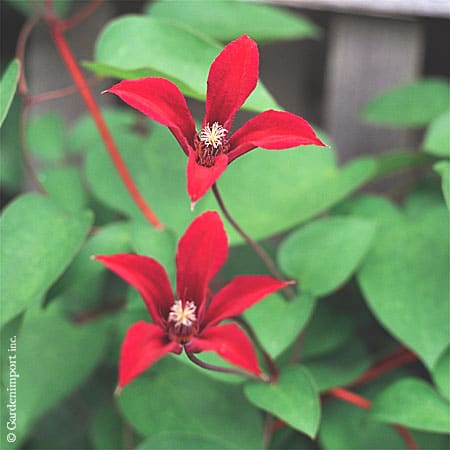
If you garden where summers are hot, it makes sense to grow flowering plants that stand up to heat waves from mid- to late summer. Several cultivars of heat-resistant Clematis texensis (Zone 5), sometimes known as Texas scarlet or leather leaf clematis (so named for its textured glossy foliage), fit into this category. The hot and dry Texas heritage of ruby-red C. texensis has persisted into the modern cultivars, making them resilient in hot weather. I particularly want clematis with red flowers to complement the many purple-flowering perennials already in the garden, and the genes for red colouring have also persisted in several cultivars of this species.
These beautiful flowering vines bloom heavily for six weeks, carrying on in full sun and heat. The species influenced ‘Gravetye Beauty’, an early cultivar bred in France about 1900. It has intense, blood red flowers three inches (8 cm) across, with widely spaced and pleated petals and a central boss of creamy white stamens. I’ll grow it on a trellis near a purple butterfly bush. If you like red clematis, also look for bluish crimson ‘Sir Trevor Lawrence’ and vibrant deep pink ‘Etoile Rose’.
I’ve always followed the instructions to plant clematis with their feet in the shade and tops in sun, often positioning them in cool partial shade. Most often I put a large, broad hosta at the foot of clematis vines to shade their roots and help keep the soil moist. However, C. texensis cultivars are more accepting of warm and dry soil conditions, and will be comfortable in full sun with good soil drainage.
Regardless of their tough heritage, however, they shouldn’t be abused. Regular irrigation is the key to keep the vines pumping out flowers from July through September. I feed all my clematis in May with a granular perennial plant fertilizer that has a higher middle number (such as 6-12-8), and that makes quite a difference in the number of flowers produced.
I won’t bother with a plant in front of each C. texensis vine, but will provide a four-inch (10-cm) mulch of leaves over the root zone. In late autumn I’ll cut the vines down to about 12 inches (30 cm) from the ground. Cutting back in autumn is preferable, as the vines sprout in early spring.
If you’ve got any kind of purple flowering plant in your garden, you might want to match it up with one of these heat-resistant red Texan beauties.









I have over twenty clematis; one is a mini. I love them all.
I loved my Gravyete Beauty clematis! Now that we live with a Black Walnut tree across the fence, I am scared to try any clematis other than Rouge Cardinal, Jackmannii and the autumn clematis.
Having grown this clematis when I lived in Ontario, I agree that it was a stunning performer. I always position a smaller shrub or perennial at the base of my many clematis regardless. It not only provides a sun block of the root zone, and therefor a living mulch, but also something visually interesting while the clematis is in its pre and post bloom periods as no matter how much I water, clematis always seem to give me a less than attractive looking base.
I do question the pruning back of a clematis in the fall. Here in my current gardening location of Nova Scotia, I fear the continual freeze and thaw cycles would be too hard on the remaining plant. I chose to do a majority of my pruning on most of my yard in Spring for this very reason.
Hi Karen,
Isn’t ‘Gravetye Beauty’ just a stunning red? Every garden has its own microclimate, and that determines a customized pruning schedule for plants. I’m sure you’re entirely correct to be cutting back in spring.
My own clematis start growing in late winter, and by the time I get out there in early spring, I’m cutting off fat buds and even some nascent foliage. I hate to waste the plant’s energy, although I know it probably wouldn’t make any difference in performance. The fertilizer I provide would certainly make up for any early growth removed in spring pruning. But I’m just getting too wimpy about this!
— Judith